
Combating healthcare staff burnout: New tech is easing pressure on overworked employees
By Hari Prasad
Significantly amplified by the pandemic, the well-being of healthcare workers is an increasingly universal concern. The resulting staff shortages burdening all our healthcare professionals with elevated workloads and are sending shockwaves through the system.
Several recent studies indicate the healthcare industry has lost about 20% of its workforce over the past few years, including 30% of nurses, many of whom are aging out of the system and not being replaced by new recruits.
Last year, the pressure on front-office administrative workers reached such alarming levels, the US Surgeon General issued an advisory. Staff burnout and accompanying resignations created a crisis in patient care and an urgent call for an intervention is being made.
A major contributing factor to staff burnout is the reduced staffing levels. The pandemic initiated many of these personnel shortages leaving the remaining staff to pick up the slack. As a result, administrative staff are stretched thin resulting in increased workloads and heightened stress levels.
The situation hasn’t eased much since the retreat of the pandemic. As a result, increased stress, fatigue, and emotional exhaustion are significantly impacting the mental health and well-being of healthcare workers. Combine this with a decreased sense of professional fulfillment and you have the recipe for burnout and, ultimately, resignation.
There is a bright spot on the horizon. Patient intake solutions have emerged as a powerful tool to help alleviate a significant part of the administrative burden. By streamlining a number of necessary but repetitive, tedious, burdensome waiting room processes, these solutions provide much-needed relief to healthcare workers and offer tangible benefits for both staff and patients.
How does that happen? A robust, configurable, and advanced patient intake solution can optimize administrative workflows, resulting in significant time savings for healthcare professionals.
Traditional administrative tasks like patient intake, appointment scheduling, and patient communication are time-consuming and demanding for healthcare staff. Countless hours are spent on the phone, admitting patients, answering queries, coordinating appointments transcribing information from the clipboard, collecting payments, etc. These routine tasks, while essential, detract healthcare providers and staff from their core responsibilities of delivering quality care.
For more details, Click Here


